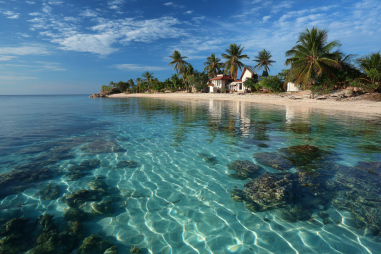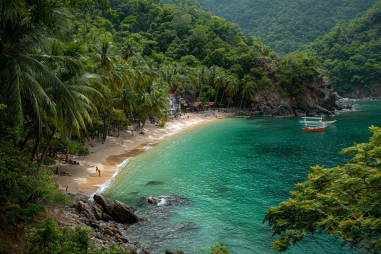Malapascua Island, a small jewel off the northern tip of Cebu in the Philippines, offers visitors pristine beaches, crystal-clear waters, and some of the best diving experiences in the country. Choosing when to visit Malapascua can make all the difference for your trip, whether you are coming for its famous thresher shark sightings, beach relaxation, or cultural festivities. Understanding the island’s climate, peak seasons, and events will help you plan your perfect getaway.
Overview of Malapascua’s Climate and Seasons
Malapascua Island experiences a tropical climate characterized by two main seasons: the dry season and the rainy season. The dry season usually spans from November to May, bringing sunnier skies, less humidity, and calmer seas. In contrast, the rainy season lasts from June to October, featuring more frequent showers, occasional storms, and rougher waters. Temperatures throughout the year typically range between 25°C to 32°C (77°F to 90°F), making it warm and inviting year-round, but seasonal weather shifts can impact your outdoor plans.
Dry Season Advantages
The dry season is often considered the best time to visit Malapascua Island, primarily due to the favorable weather conditions. During these months, especially between February and May, the island enjoys clear blue skies, bright sunshine, and calm seas — perfect for beach activities and diving adventures.
Diving conditions during the dry season are at their prime. Visibility underwater can reach up to 30 meters, making it easier to spot Malapascua’s famous marine life, including the elusive thresher sharks at Monad Shoal. The calm seas also ensure boat trips are smooth and less likely to be canceled due to weather.
Additionally, the dry season allows for comfortable trekking and island hopping, giving travelers more opportunities to explore neighboring islets or enjoy outdoor cafes and sunset viewing points without interruption.
Rainy Season Considerations
While the rainy season from June to October might seem less appealing due to frequent rain and occasional typhoons, visiting Malapascua during this period has its unique benefits. The island is noticeably quieter and less crowded, which may appeal to travelers seeking a peaceful retreat.
It’s worth noting that while rain showers can be heavy, they are often brief, allowing for some sunny periods during the day. The rains also bring a lush vibrancy to the island’s landscape, with greener vegetation and cooler temperatures.
If you plan to dive during the rainy season, be prepared for possibly reduced visibility and occasional rough boat rides. Some dive sites may be less accessible, but local dive operators usually adjust their schedules to offer safe and worthwhile excursions.
Peak Tourist Times and Crowd Levels
The busiest months on Malapascua Island align with the dry season, particularly from December to March, coinciding with the Philippine holiday season and the peak of international tourism. During these months, accommodations can fill up quickly, and popular dive spots and beaches may be more crowded.
April and May, although still dry, tend to be slightly quieter, offering a good balance between good weather and lower tourist density. This period is ideal for travelers wanting to experience Malapascua without the hustle of peak season crowds.
On the other hand, the rainy season naturally sees fewer tourists, offering benefits for those who prefer solitude but requiring flexibility in planning activities dependent on the weather.
Special Events and Festivals
Malapascua Island hosts several cultural and community events that can add a rich local dimension to your visit. One of the most notable festivities is the Feast of San Pascual Baylon, the island’s patron saint, celebrated each May with lively parades, masses, and traditional dances.
Timing your trip to coincide with this festival means experiencing authentic local culture, flavorful Filipino cuisine, and the warm hospitality of the Malapascuan community. Additionally, various diving competitions or eco-awareness events sometimes take place during the dry season, which can be a great opportunity to meet fellow enthusiasts and learn more about marine conservation efforts.
Tips for Travelers on Weather-Related Packing
Packing smartly can greatly enhance your Malapascua experience no matter the season:
- For the Dry Season: Bring lightweight, breathable clothing, plenty of sunscreen, swimwear, snorkel gear if you have your own, and sunglasses. A wide-brimmed hat and rash guard are helpful for sun protection during water activities.
- For the Rainy Season: Pack a reliable rain jacket, quick-dry clothing, waterproof bags for electronics, and sturdy sandals or water-resistant shoes. An umbrella can be useful, though a rain jacket is preferred for ease during activities.
In all seasons, don’t forget essentials like insect repellent, especially if you venture into natural or forested areas, and waterproof phone cases or bags to protect your gadgets during boat trips or sudden showers.
Planning Your Visit According to Your Interests
When deciding the best season to visit Malapascua Island, think about what activities you prioritize:
- Diving: Best during the dry months (February to May), with optimal visibility and calmer seas.
- Beach Relaxation: Dry season offers the most sunny days and pleasant beach weather.
- Cultural Experiences: Plan for May to enjoy the Feast of San Pascual Baylon and other local celebrations.
- Budget Travel and Solitude: Consider the rainy season when accommodation prices drop and the island is less crowded, keeping in mind weather limitations.
Ultimately, Malapascua Island is a year-round tropical paradise, but the timing of your visit can shape how you experience its natural and cultural treasures. Whether you want to dive into the ocean’s depths, bask on powdery white sand, or immerse yourself in local traditions, choosing the right season will set the stage for unforgettable memories.







